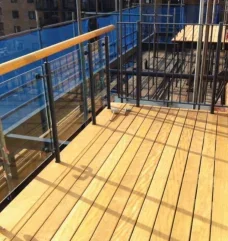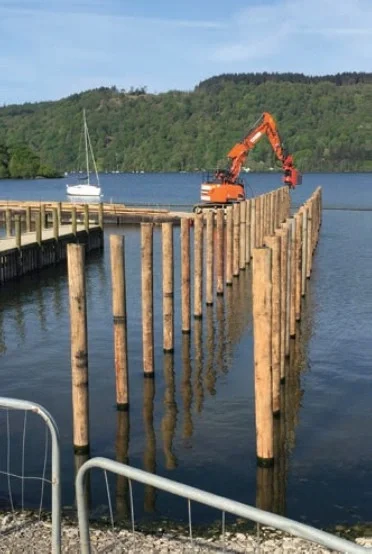
Provided they’re sourced from third-party verified sustainably managed forests, their technical capabilities make many tropical species ideal substitutes for finite-materialbased energy intensive materials, especially in exterior applications. Developing the market for them can also incentivise uptake of sustainable tropical forest management. It’s potentially an emission cutting, climatechange mitigating virtuous circle.
That’s the view of Mike Bekin, founderdirector of Cambridge-based Ecochoice. He acknowledges the sector faces challenges in terms of lack of market awareness of tropical timber’s performance characteristics, notably of what might be termed nonmainstream species. There is also still a job to be done to spread the word on their environmental credentials, including the fact they are available backed with sustainability certification. But he’s convinced that with an industry-wide effort to communicate the multiple values of tropical timbers, including that their use can help combat deforestation, and growing realisation that construction must decarbonise, they can play an increasingly important role in the market.
Ecochoice supplies lumber and wood products in temperate hardwoods, clear and treated softwood plus thermo-treated timber. But it has a particular reputation for certified tropical timber. Its website lists around 100 species.
“When we started back in 2005, there was very little knowledge in the market about tropical species, and even more about their traceability,” said Mr Bekin. “We decided to close this knowledge gap, including because we see wider use of sustainably sourced tropical species as the neatest solution for protecting endangered forests.”
Using a broader spread of tropical timber, he argues, is good for the forest and makes certification more economically attractive.

“The use of lesser-known species helps to lower the pressure on the few famous ones and, from the sustainable forest management perspective, means there is more yield per hectare,” he said. “It makes the whole operation more viable, so ultimately there’s more certified wood for everyone.”
He named several species that can take the supply strain off market favourites.
“We work a lot with ekki as it’s a great alternative to greenheart for heavy civil, marine and rail works, and its available in bigger sections,” he said. “Then there’s jatoba, a lovely Brazilian species that’s perfect for decking, yet cheaper than ipe and cumaru. And finally, padouk, a fantastic alternative to iroko – much more stable and with good availability.”
But how to persuade specifiers, end-users and ultimately consumers to choose these species when they may not even have heard of them.
“It’s not easy, I’ll be honest,” said Mr Bekin. “We do rely mainly on persuading the specifiers and end-users, although some merchants are incredibly open minded too. But sometimes all it takes is a few pictures of projects, or a PDF of a technical sheet.”
All Ecochoice’s tropical range is FSCcertified.
“Sometimes we do struggle to find the exact certified match to each enquiry,” said Mr Bekin. “But in these cases, we offer an alternative.”
Ecochoice doesn’t share the criticism of the main international forest and timber sustainability certification systems, that they haven’t become big enough quickly enough in terms of hectarage covered. Although, he would like to see wider support to drive them forward and maximise the environmental, economic and social benefits they can deliver.
“The FSC has over 160 million hectares of forests certified, and the total UK land area is 25 million hectares, so it’s quite significant for a voluntary system,” he said. “But to turbo charge forest conservation and massively help what they can do for climate change mitigation, I’d like to see governments committing their forest areas to sustainable forest management under FSC standards. These require great care and protection is taken, not only of forests and notably their high conservation value areas, but also of the local people.”
There are other brands of sustainable forest management validation out there, of course. For example, Timber Development UK is an advocate for the Broader Market Recognition Coalition (BMRC), a group of tropical countries pledged to establish national sustainable forestry systems that are embedded in law and cover the entire country. Ecochoice backs all efforts “to promote sustainable tropical timber to the wider market”, but also raises question marks.
“The impetus to strengthen national forestry standards is always good news,” said Mr Bekin. “The question is how they define sustainable forestry – and harmonising that notion is very difficult across borders and cultures. There’s also the danger of confusing consumers with yet another compliance brand. This is why I believe third party verification to globally recognised standards is the way forward and that FSC is so relevant. It offers end users the assurance that forests are independently audited under one global banner.”
Ecochoice does not, of course, advise use of tropical timber above all other timber types. It’s about fitness for purpose. For example, it is also a strong advocate for thermo-treated products.
“I think that thermo modification technology has effectively created a new breed of timbers, almost like new species,” said Mr Bekin. “They are very different from the original untreated species and fulfil a great space in the market for projects that want stability, no-chemicals, longevity and light weight, but not at the premium price of some tropical species such as cumaru or iroko. To me these qualities are the answer for 95% of all cladding projects, so I’m a huge fan of thermo-treated timber.”
Wood plastic composites (WPC), however, not so much.
“WPC may address some of the plastic landfill questions, but not fully. Plastic is not a circular material, and is high embodied energy,” said Mr Bekin. “So, I’d be happy if we focused on reducing use of plastic rather than finding ways to recycle it and advocate wood for all decking, cladding and bench requirements.”
Ecochoice also urges making the case even more strongly for timber generally and tropical timber in particular to substitute carbon steel, concrete, plastic and other high embodied carbon materials and so reduce construction’s massive CO2 emissions.
“This is probably our key message – if you can use wood from certified sources, you should definitely give it a go,” said Mr Bekin. “I know the TTJ readership understands really well the fact that timber is both renewable and a carbon sink, but as an industry we really ought to push this message louder to the general construction market. TDUK is doing a great job in this respect, but we’ve got a massive hill to climb called culture. It’ll take some time, but climate change makes it imperative that designers and end users learn more about the footprint of their building materials – and nothing comes close to timber’s environmental performance.”
He added that he’s also not against still stricter regulation of the timber market to ensure legality and sustainability of supply. That includes the EU Deforestation Regulation, which now comes into force at the end of 2025. It demands companies that place timber and other so-called forest and ecosystem risk commodities (FERCs) on the EU market, or export them from the latter, undertake due diligence to ensure their production has not led to deforestation or forest degradation. And given it is so heavily dependent on wood imports from the EU, and exports finished wood products there, the UK will inevitably be impacted.
“We’ve had the EU and UK Timber Regulations (EUTR and UKTR) for 10 years now and not a lot has changed, so I think it’s fair for the bar to be raised when it comes to sourcing timber and other commodities responsibly,” said Mr Bekin. “I come from Brazil where beef and soya are by far the largest contributors to deforestation and forest degradation, with huge carbon emissions as a consequence. At the same time, we can’t promote timber as a zero or low carbon solution if we are not able to prove it hasn’t caused any deforestation at source – and 8% of global emissions come from deforestation. Yes, it will be a bit of a pain to get the systems in place for the EUDR, but once we get over that hurdle, I expect the outcome of having verified deforestation-free timber will be that our selling proposition becomes even more compelling.”





